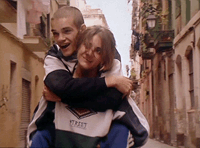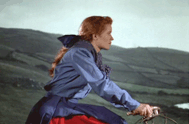 En Construcción, 2001. Something of a cross between the organic essentiality of Johan van der Keuken’s ethnographic documentaries (most notably, in I Love Dollar) and the disenfranchised cinema of Pedro Costa, José Luis Guerín’s En Construcción anticipates Jia Zhang-ke’s Still Life in its understated, yet bracing portrait of economically imposed dislocation, class stratification, and cultural erasure. Ostensibly a chronicle of the construction of a condominium as part of a multi-phased, residential development project intended to revitalize the working class Barcelonan port town of El Chino (whose name had been derived from its once bustling commerce as a trade port to Asia), the film is also a provocative and poetic document of marginalized, discarded lives lived within the constant flux of demolition and construction, urbanization and depopulation in the pursuit of an economic renaissance that comes with the process of gentrification – the people on the figurative other side who are slowly being pushed away from these transforming communities: the migrant, day laborers (usually foreigners or people from rural provinces) who work on the construction site without the security of continued employment after the project is completed, and impoverished townspeople who look on at the construction activity from the windows and rooftops of their own worn down tenements (often scheduled for future demolitions themselves), unable to afford the price of an apartment unit in the new building. This underlying dichotomy is tersely encapsulated by the plight of a young couple, Juani and Iván who, as the film begins, have been given a notice of eviction by the landlord after falling behind on their rent (as well as receiving underhanded threats to implicate Juani’s mother in a lawsuit if they refuse to comply). Juxtaposing their impending homelessness against a shot of a wrecking crew throwing out the contents from a room of a gutted apartment building with a graffiti bearing Juani’s name (while passersby rummage through the contents of the dumpster and retrieve a painting that had once been hanging on the couple’s wall) in preparation for clearing the site for new construction, Guerín subverts the notion that area redevelopment creates a new economy, but rather, merely supplants the old one.
En Construcción, 2001. Something of a cross between the organic essentiality of Johan van der Keuken’s ethnographic documentaries (most notably, in I Love Dollar) and the disenfranchised cinema of Pedro Costa, José Luis Guerín’s En Construcción anticipates Jia Zhang-ke’s Still Life in its understated, yet bracing portrait of economically imposed dislocation, class stratification, and cultural erasure. Ostensibly a chronicle of the construction of a condominium as part of a multi-phased, residential development project intended to revitalize the working class Barcelonan port town of El Chino (whose name had been derived from its once bustling commerce as a trade port to Asia), the film is also a provocative and poetic document of marginalized, discarded lives lived within the constant flux of demolition and construction, urbanization and depopulation in the pursuit of an economic renaissance that comes with the process of gentrification – the people on the figurative other side who are slowly being pushed away from these transforming communities: the migrant, day laborers (usually foreigners or people from rural provinces) who work on the construction site without the security of continued employment after the project is completed, and impoverished townspeople who look on at the construction activity from the windows and rooftops of their own worn down tenements (often scheduled for future demolitions themselves), unable to afford the price of an apartment unit in the new building. This underlying dichotomy is tersely encapsulated by the plight of a young couple, Juani and Iván who, as the film begins, have been given a notice of eviction by the landlord after falling behind on their rent (as well as receiving underhanded threats to implicate Juani’s mother in a lawsuit if they refuse to comply). Juxtaposing their impending homelessness against a shot of a wrecking crew throwing out the contents from a room of a gutted apartment building with a graffiti bearing Juani’s name (while passersby rummage through the contents of the dumpster and retrieve a painting that had once been hanging on the couple’s wall) in preparation for clearing the site for new construction, Guerín subverts the notion that area redevelopment creates a new economy, but rather, merely supplants the old one.
In documenting the discovery of ancient relics from a suspected Roman-era catacomb at a demolished building site (a theory that is acerbically rebutted by an elderly bystander who is convinced that the corpses had instead been buried there during the dark days of the Civil War), Guerín not only expounds on the film’s prefiguring images of cultural disposability and substitution, but also underscores the theme of inorganic structure as testaments of “living history”, a preoccupation that resonates with Alain Resnais’s early cinema in his recurring expositions on architectural memory. This idea of human imprint as encapsulated (and inerasable) records of history is visually reflected, initially, in the establishing shot of a large, four panel graffiti mural of eternal eyes that is mirrored in the children’s chalk drawings at the construction site, then subsequently, in the foreman, Juan López’s correlation of a building’s structural framework to an inanimate soul – the hidden substance that defines an object’s underlying integrity. Within this metaphysical analogy, the indelible images of deformed silhouettes as passersby invariably peek through the canvas enclosure along the perimeter of the construction site to watch the activity that is also evoked in the exaggerated shadows cast on adjacent walls as laborers work through the evening may also be seen as metaphoric figurations of transcended bodies. It is in this aesthetic representation of spaces as interchangeable, transitory containers for human existence that Guerín’s haunting exposition ultimately converges towards the displaced spirit of Chantal Akerman’s cinema, where concreteness of place is an untenable illusion, and the idea of home proves to be arbitrary and elusive.
 Tren de sombras, 1997. Ostensibly framed as a restoration of a degraded found film recovered some 70 years after the sudden and unexplained death of its creator, a Parisian attorney and amateur filmmaker named Gérard Fleury at a lake in the village of Le Thuit in Normandy, Tren de sombras is a dense, sensual, and richly textured exposition of José Luis Guerín’s recurring preoccupations: the nature and subjectivity of the image-gaze, the permeable borders between truth and fiction, the role of architecture (and landscape) as palimpsest of hidden histories. By placing the discovery of Fleury’s last shot footage of his home and family within the context of the ambiguity surrounding the circumstances of his death after a seemingly innocuous scouting trip early one morning to find suitable lighting conditions to incorporate into his home movie, the found film becomes both a curious artifact of the early days of cinema in its informally staged performances that suggest the whimsical, created illusions of Georges Méliès (in a performance of dancing ties and magic tricks), and also a non-fiction, historical record that can be deconstructed, reconstituted, and re-analyzed to glean further information into the real-life mystery.
Tren de sombras, 1997. Ostensibly framed as a restoration of a degraded found film recovered some 70 years after the sudden and unexplained death of its creator, a Parisian attorney and amateur filmmaker named Gérard Fleury at a lake in the village of Le Thuit in Normandy, Tren de sombras is a dense, sensual, and richly textured exposition of José Luis Guerín’s recurring preoccupations: the nature and subjectivity of the image-gaze, the permeable borders between truth and fiction, the role of architecture (and landscape) as palimpsest of hidden histories. By placing the discovery of Fleury’s last shot footage of his home and family within the context of the ambiguity surrounding the circumstances of his death after a seemingly innocuous scouting trip early one morning to find suitable lighting conditions to incorporate into his home movie, the found film becomes both a curious artifact of the early days of cinema in its informally staged performances that suggest the whimsical, created illusions of Georges Méliès (in a performance of dancing ties and magic tricks), and also a non-fiction, historical record that can be deconstructed, reconstituted, and re-analyzed to glean further information into the real-life mystery.
The dual nature of film is similarly suggested in the multilayered transitional shot between Fleury’s footage from 1930 and modern day Le Thuit – the image of a caretaker sweeping leaves at a sidewalk corner overlooking a cemetery as schoolchildren cross at the intersection, a folding billboard advertising a cinémathèque program featuring pioneering filmmakers propped against a lamppost on the edge of the frame – visually repeating interchangeable themes of decay (fallen leaves, graveyard, film nitrate) and renewal (children, film revival, the act of sweeping). Interweaving depopulated, still-life compositions that alternately show ethereal images (casted shadows, lake mist, clouds, rays of light poking through occlusions, reflections on mirrors and windows) and physical objects (landscape, architecture, framed photographs, clocks, period furniture, camera equipment), Guerín further expounds on the idea of film as a medium of materiality and immateriality, where filmmaking itself becomes an act of creation (in capturing images that do not physically exist), destruction (in the chemical degradation of the medium), and transformation (in the projection of material into light). Moreover, by introducing sequences that overtly demonstrate the image manipulation of Fleury’s unfinished film (with the apparent motive of finding hidden clues to the mysterious death) – splicing damaged footage, matching cuts that illustrate parallel gestures and expressions, freeze frames and zooms that provide detailed observation – Guerín not only reflects on filmmaking as a godlike process of suspension and reanimation, but also on the inherent responsibilities (and limitations) that it enables in creating permutations of the story, where truth is arbitrarily defined by editing, and the idea of closure to a story is negated by the competing idea that the same film can be rewound, reconfigured, and re-edited into a plurality of equally valid, alternate endings. It is this open-endedness that is reflected in the film’s long take, closing shot of a dead-end street intersection in Fleury (a recurring aesthetic that also surfaces in Guerín’s En Construcción and In the City of Sylvia), where people momentarily pass into and out of frame – each passerby representing another open story, each passage, a corridor leading to new, alternate angles of perspective and (re)discovery.
 Innisfree, 1990. As in Tren de sombras, José Luis Guerín ambiguously prefaces Innisfree as a series of images and observations recorded from the site of a historical event, in this case, the filming of John Ford’s The Quiet Man around Cong village in the Irish countryside. And like the film, Guerín alternates between modes of non-fiction – documentary and found footage – to explore the amorphous nature of image creation and representation, the impreciseness of translation, and the imprinting of historical (and geographical) memory. Guerín prefigures the deconstruction of Ford’s film (and, implicitly, Ford’s persona as the town’s famed native son) in the opening commentary by the director’s friend and colleague, Michael Killanin (producer of The Rising of the Moon) on the absence of primogeniture tradition in Irish culture that had led to large scale emigration during the last century (as subsistence farmers inherited subdivided land or were completely disinherited and forced to seek their fortune elsewhere). Framed against a shot of two men (presumably Ford’s relatives, the O’Feeneys) surveying the stone wall ruins of a farmhouse, Guerín illustrates both the reality (of abandoned land) and implied fiction (of returning émigrés) intrinsic in Ford’s seemingly autofictional premise of an Irish American boxer, Sean Thornton (John Wayne) returning to his ancestral land in order to reclaim his homestead.
Innisfree, 1990. As in Tren de sombras, José Luis Guerín ambiguously prefaces Innisfree as a series of images and observations recorded from the site of a historical event, in this case, the filming of John Ford’s The Quiet Man around Cong village in the Irish countryside. And like the film, Guerín alternates between modes of non-fiction – documentary and found footage – to explore the amorphous nature of image creation and representation, the impreciseness of translation, and the imprinting of historical (and geographical) memory. Guerín prefigures the deconstruction of Ford’s film (and, implicitly, Ford’s persona as the town’s famed native son) in the opening commentary by the director’s friend and colleague, Michael Killanin (producer of The Rising of the Moon) on the absence of primogeniture tradition in Irish culture that had led to large scale emigration during the last century (as subsistence farmers inherited subdivided land or were completely disinherited and forced to seek their fortune elsewhere). Framed against a shot of two men (presumably Ford’s relatives, the O’Feeneys) surveying the stone wall ruins of a farmhouse, Guerín illustrates both the reality (of abandoned land) and implied fiction (of returning émigrés) intrinsic in Ford’s seemingly autofictional premise of an Irish American boxer, Sean Thornton (John Wayne) returning to his ancestral land in order to reclaim his homestead.
This duality is also reflected in the juxtaposition of Killanin’s comments with the appearance of a hitchhiker. On one hand, Killanin points out that Thornton is, to some extent, an alterego (whose shared history with Ford involved immigrant parents who settled in Pittsburgh) and represents an idealized, other gaze that goes against the grain of historical reality. On the other hand, the hitchhiker represents an antithesis to the immigrant story by describing her experience as having worked as an au pair and in a millinery factory in Pittsburgh before deciding to return home to Ireland. The convergence of disparate realities is further developed in the young woman’s employment as a concession stand attendant for one of the local, film-themed sightseeing tours that now capitalize on the popularity of The Quiet Man. In a sense, fiction and reality not only coexist (an idea that is also suggested in the deliberately staged shot of the attendant, still in her Maureen O’Hara costume, riding home that evokes a shot of the bicycling couple in Ford’s film), but that fiction has also transfigured into reality by creating (and perpetuating) its own illusion.
The transformation of Innisfree from scouted, rustic town suitable for the location shoot to one now defined by – and economically reliant on – perpetuating the fictional images created by the film also reflects Guerín’s theme of cinema as simultaneously a medium of illusion and conjurer of reality (a theme that also surfaces in Tren de sombras in the figurative conjuring of the dead by restoring amateur filmmaker, Fleury’s lost film from the turn of the century). In one episode, film reality diverges from geographic reality when an IRA partisan describes the war torn, mine-filled landscape that was cleared to create the film’s idyllic images of pastoral life. In a subsequent episode, the two realities again converge in a staged explosion caused by an errant cow for Guerín’s film. In both cases, the landscape has been altered by artificially constructed, historical realities. Similarly, by using repeated shots of the attendant shuffling full-scale cutouts of John Wayne and Maureen O’Hara at a tour site (the scenes wryly cued by opening and closing the shutters of the small, puppet-theater sized concession stand), Guerín reflects on the idea that the town, too, has become a modern day, real-life staged spectacle. Concluding with images of the hitchhiker moving on to another town in search of job opportunities, she becomes an embodiment of the immigrant paradigm and a traveling performer for Guerín’s camera.
Acquarello, 2007-2009 [reprinted]